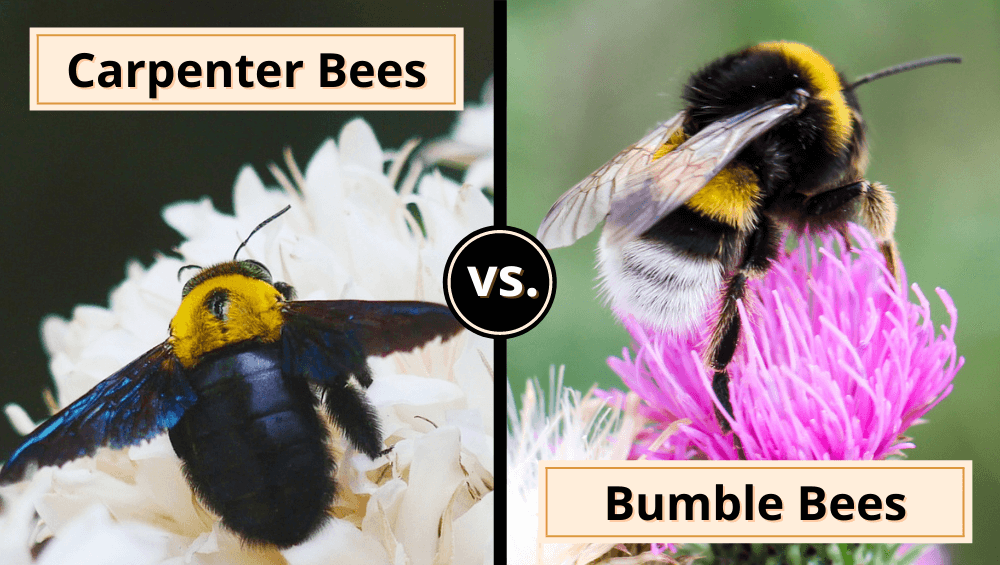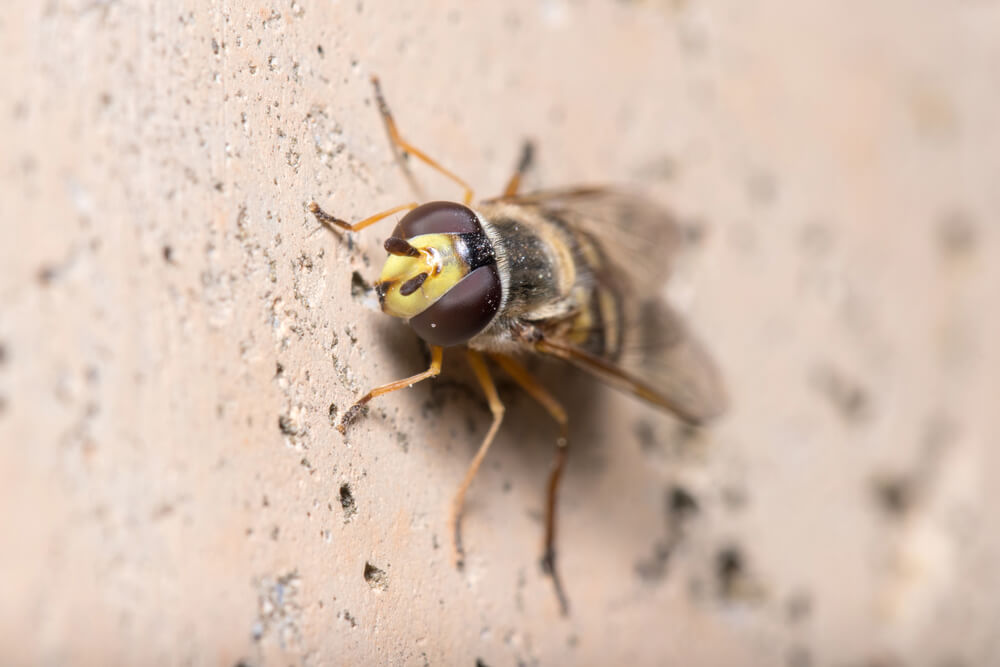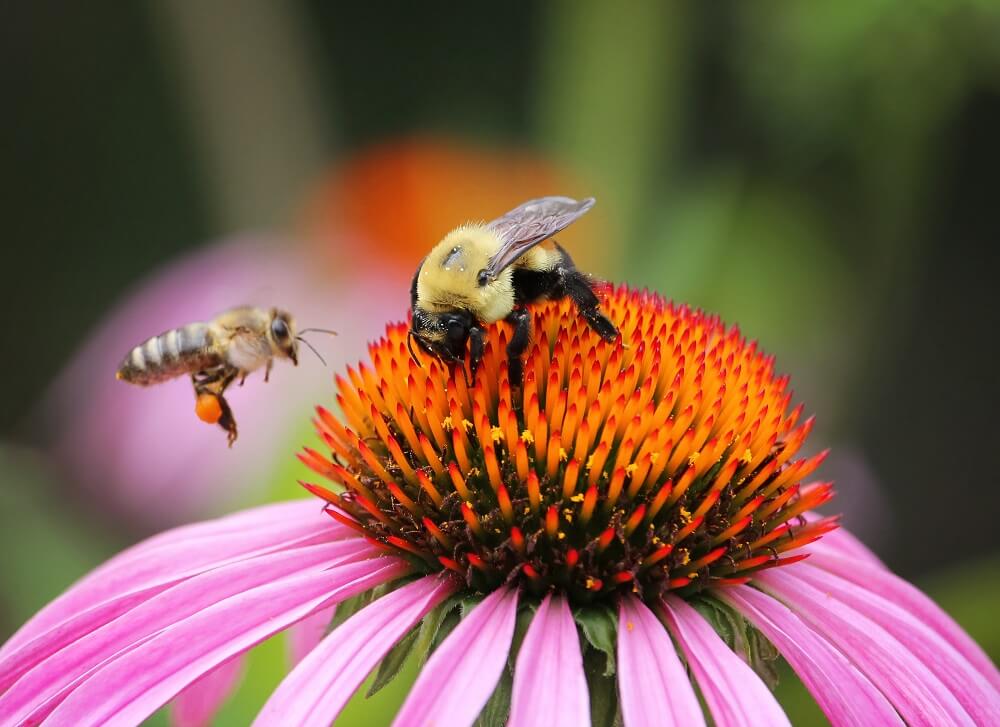Table of Contents:
Carpenter Bee vs. Bumble Bee: Appearance

We’ve all seen them.
Large, fuzzy bees that buzz around quickly. They fly so fast that it’s hard to get a clear view of what kind of bee they are. They usually have yellow and black coloring and look like bumblebees.
But are they truly bumblebees?
Here’s the thing:
The easiest way to tell bumblebees and carpenter bees apart is to look at their abdomen.
Carpenter bees have shiny, black abdomens with little to no fuzz on them. In contrast, bumblebees are completely covered in fuzz from head to toe.
And get this:
Carpenter bees and bumblebees are the largest native bees in the United States. They both measure about one inch long, making carpenter bees and bumblebees about twice the size of honeybees.(1)

But this is where it gets tricky.
Carpenter bees and bumblebees don’t always stay still long enough for you to tell them apart.
So another way to distinguish them is by their flight patterns. Carpenter bees tend to dart through the air, hover for a second, then dart again. Bumblebees fly in straighter lines and hang around flowers.
You’ll also notice that carpenter bees are more likely to chase each other. This is because male carpenter bees battle it out by chasing and bumping into each other. They use this head-butting technique to fight over females and defend their nests.
But that’s not all.
Pay attention to where the bees are hovering. For example, carpenter bees are attracted to wood because that’s where they build their nests. So if you see the bees buzzing around your roof eaves or wooden porch, it’s probably a carpenter bee.
Speaking of that, let’s talk about where they live.
Carpenter Bee vs. Bumble Bee: Nests

Let’s start with the obvious.
Carpenter bees get their name from their habit of drilling into wood.
Female carpenter bees have strong jaws (mandibles) that allow them to bore into wood to build their nests. They prefer unpainted, weathered wood such as cedar, cypress, pine, and redwood. Painted or stained wood will usually deter carpenter bees.
But despite popular belief:
Carpenter bees don’t eat wood like termites do. Like other bees, carpenter bees are essential pollinators that eat pollen and nectar from flowers. In fact, 15% of our crops are pollinated by native bees such as carpenter bees.(2)
So make no mistake.
Even though carpenter bees can be considered pests to some, they’re actually important pollinators. And the good news is that carpenter bees can be deterred easily using natural methods that won’t hurt them.
Now, what about bumblebees?
Bumblebees don’t drill into wood. Instead, they nest underground in abandoned rodent holes, under sheds, and in thick vegetation. Unlike carpenter bees, bumblebees are social bees that live in colonies. These colonies comprise of 50 – 500 bumblebees.

More specifically:
Bumblebee colonies include a queen bee, worker bees (females), and drone bees (males). They work together as a family to survive.
Carpenter bees are different.
Besides the fact that carpenter bees build their homes in wood, they’re also mostly solitary bees. This means they live alone and don’t have the help of dozens or hundreds of family members.
Female carpenter bees are solely responsible for building their nests and collecting food for themselves and their larvae.
Male carpenter bees are responsible for hovering outside the nest and warding off predators. As a result, male carpenter bees generally have the most interactions with humans.
And I’ll say it again:
Carpenter bees don’t eat wood. They only tunnel into it to build their homes.
Instead, carpenter bees eat nectar and pollen from flowers like bumblebees do. This makes carpenter bees crucial pollinators that should be deterred using only natural methods.
Carpenter Bee vs. Bumble Bee: Sting
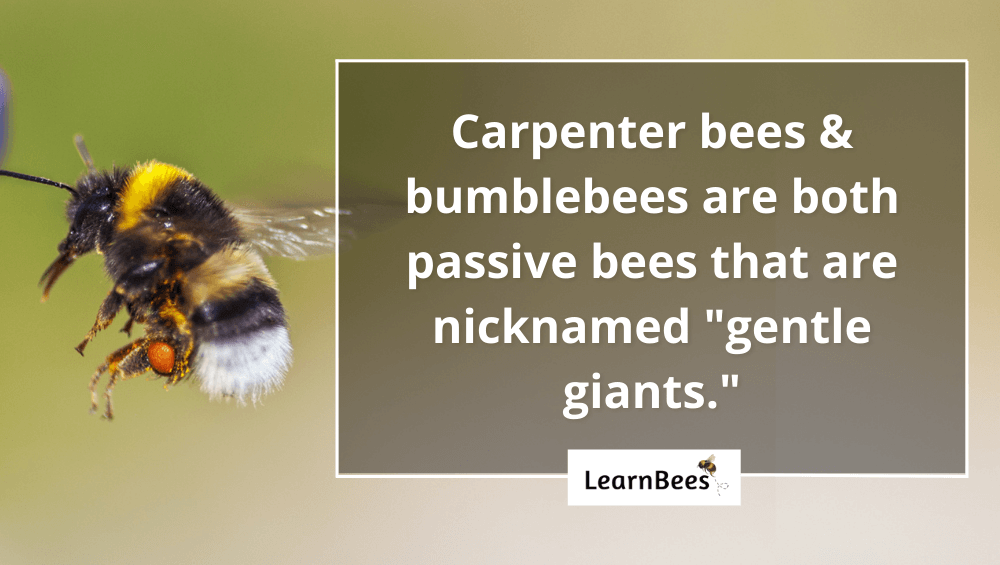
Want to hear something surprising?
Only female bees can sting. Male bees cannot. This is true for all bee species, including bumblebees, carpenter bees, honeybees, mason bees, and so on.
How come, you ask?
Let me explain. Male bees can’t sting because they don’t have stingers. Stingers are modified egg-laying devices, so only female bees have them.
So when it comes to protecting their nests?
Male bees are all talk.
But that doesn’t stop them from trying. For example, male carpenter bees put on a threatening display to deter intruders. They’ll buzz around them quickly, sometimes butting into them. This usually does the trick for scaring predators away.
And remember:
This means that you’re more likely to run into male carpenter bees than females. Female carpenter bees are busy nesting, collecting food, and laying eggs. Male carpenter bees stay on surveillance over their nests, so they have more human interaction.

But let me clarify:
Bees are generally gentle creatures. Female bees won’t sting unless they’re seriously provoked. As long as you don’t touch them or poke your fingers into their nest, you usually have nothing to worry about.
Sure, male carpenter bees will put on a big show. But they can’t sting you because they don’t have stingers. Just back away and avoid swatting at them. And read our guide on how to get rid of carpenter bees naturally.
Now here’s the thing:
Bumblebees and carpenter bees differ in their behavior.
For example, female bumblebees have more interactions with humans than male bumblebees do. This is because female bumblebees are the worker bees who do all the heavy lifting for their hive.
For example, female bumblebees’ job duties include:
- Collecting pollen and nectar for food
- Cleaning the nest
- Taking care of the queen
- Taking care of the baby bees
- Protecting their hive
- Making honey
This means most of the bumblebees you see buzzing around flowers are female worker bumblebees.
Conversely, male bumblebees are responsible for mating with queens from other hives. They don’t protect the nest, clean it, or do much of anything else.
Male bumblebees simply focus on mating. That said, this is a simple yet important job role because it ensures the future generation of bumblebees.
Carpenter Bee vs. Bumble Bee: Pollination

Bumblebees and carpenter bees have one very important thing in common:
They’re both buzz pollinators.
Why does this matter?
Because several important crops require buzz pollination, including potatoes, tomatoes, blueberries, eggplants, and kiwis. But not all bees can buzz pollinate. For example, honeybees can’t buzz pollinate like carpenter bees and bumblebees can.(3)
Buzz pollination is the term used to describe pollinators who literally shake pollen out of flowers. They do so by grabbing onto the flower using their jaws and then vibrating their wings rapidly. Such vibrations knock the pollen loose so the bees can collect it.
And here’s the thing:
Because of their large size, bumblebees and carpenter bees can’t fit inside small flowers. So sometimes, they’ll make small incisions in the base of the flower to collect nectar.
If you want to help your local bumblebees and carpenter bees, the best flowers to plant are:
Your garden will become a pollinator magnet if you plant these flowers.
Carpenter Bee vs. Bumble Bee: Lifespan

Carpenter bees have longer lifespans than bumblebees do. Bumblebees are annual bees, meaning they don’t survive for multiple years. New generations of bumblebees are born and replaced each year.
Also, remember that bumblebees are social bees that live in colonies consisting of a queen, worker bees, and drone bees. Carpenter bees are mostly solitary bees with only a single male and female.
Compare the lifespans of the two bees:
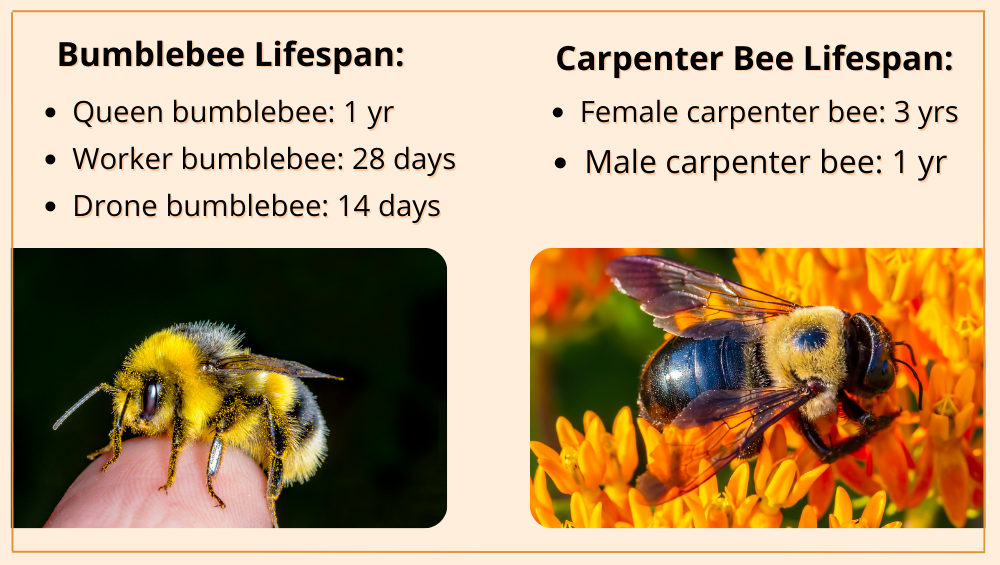
In a bumblebee colony, the queens are the only bees to survive the winter. The rest of the colony dies while the newly hatched queen hibernates. Once spring arrives, the queen bumblebee starts nesting.
Female carpenter bees also hibernate during the winter. The main difference is that the female carpenter bees survive several winters by hibernating. Queen bumblebees only survive one winter.
FAQs on “Carpenter Bee vs. Bumble Bee”
- Do bumblebees look like carpenter bees?
- Do bumblebees make holes in wood?
- Are carpenter bees and bumblebees the same?
Do bumblebees look like carpenter bees?
People often ask:
How do you tell if a bee is a carpenter bee? What’s the difference between a carpenter bee and a bumblebee?
The answer is that bumblebees and carpenter bees can look a lot alike. Both types of bees are large and can have similar coloring. However, carpenters bees and bumblebees are different bee species with slight physical differences.
For example, carpenter bees have a smooth and shiny abdomen with little to no fuzz on it. Contrastly, bumblebees are covered from head to toe in fuzz. Bumblebees are usually striped with yellow/black, orange/black, or red/black.
Carpenter bees can have various colors, including yellow/black, all black, and even shades of violet.
But the carpenter bees that get mistaken for bumblebees are usually yellow and black. They have yellow thoraxes (upper back) with black, hairless abdomens.
Both bumblebees and carpenter bees are similar in size. They measure about one inch long, making them the largest bees in the United States. For comparison, carpenter bees and bumblebees are about twice the size of honeybees.
That said, sometimes it’s hard to tell bumblebees apart from carpenter bees because they don’t stay still long enough. You can’t get a good look if they’re constantly buzzing around.
So here’s a tip:
Bumblebees and carpenter bees typically have different flight patterns.
For example, carpenter bees tend to dart through the air with quick, sharp movements. They’ll dart for a second, then hover shortly, and dart off again.
You’ll also notice that carpenter bees will chase each other. This happens when male carpenter bees battle it out over females. They bump into each other as a way of fighting.
On the other hand, bumblebees fly in straighter lines and don’t usually fight. They simply buzz from flower to flower in search of food.
—> Go back to the FAQs on “Carpenter Bee vs. Bumble Bee”
More to Explore:
- Do Bumble Bees Make Honey?
- Do Bumble Bees Sting?
- Do Carpenter Bees Sting?
- What Do Carpenter Bees Eat?
Do bumblebees make holes in wood?
No, bumblebees don’t drill holes into wood like carpenter bees do. People usually ask this question because they’re mistaking bumblebees for carpenter bees.
It’s an easy mistake.
Bumblebees closely resemble carpenter bees. They can have similar shapes, sizes, and coloring. That said, they’re two totally different bee species with unique habits.
For example, carpenter bees bore into wood because that’s where they build their nests. In contrast, bumblebees nest underground in empty mouse burrows, piles of vegetation, or inside open logs.
Carpenter bees are different. They prefer to nest in untreated wood. That said, sometimes they will drill into treated wood if they’re short on options. But mostly, carpenter bees prefer unpainted or unstained wood.
And if given a choice, carpenter bees will drill their nests into weathered wood over new wood.
Keep in mind:
Despite their reputation as pests, carpenter bees are actually crucial pollinators. They gather pollen and nectar like other bees do. This means they don’t eat wood like many people believe. They just use it to build their homes.
With that in mind, if you want to deter carpenter bees, read our guide on how to get rid of carpenter bees naturally.
—> Go back to the FAQs on “Carpenter Bee vs. Bumble Bee”
More to Explore:
- Do Bumble Bees Bite?
- Do Carpenter Bees Pollinate?
- Are Carpenter Bee Stings Dangerous?
- How Long Do Bumble Bees Live?
Are carpenter bees and bumblebees the same? What are the similarities between bumblebees vs. carpenter bees?
No, carpenter bees and bumblebees are two different bee species. They look similar, but they have different lifecycles, nesting habits, and behaviors.
That said, carpenter bees and bumblebees are both pollinators that help crops and flowering plants across the globe. It might surprise you to learn that one in three bites of food we eat is thanks to pollinators.
Without them, many plants would cease to exist.
